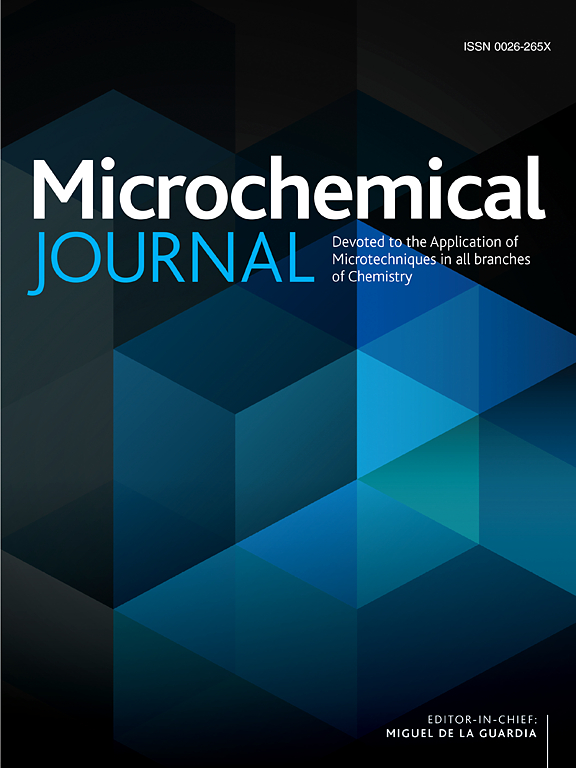Oxygen vacancy-rich NiCo2O4 nanoparticles loaded on polyaniline nanowires for highly selective Pb2+ electrochemical sensing
IF 4.9
2区 化学
Q1 CHEMISTRY, ANALYTICAL
引用次数: 0
Abstract
To satisfy the pressing demands for heavy metal ions (HMIs) detection, A novel sensor was developed to detect lead (Pb2+) ions based on oxygen vacancy-rich NiCo2O4 (NCO) nanoparticles and polyaniline (PANI) nanowires. The NCO/PANI nanocomposite was synthesized via a synergistic salt-assisted carbonization activation and conductive polymers doping strategy, which simultaneously introduced abundant oxygen vacancies and optimized the heterostructure interface. The NCO nanoparticles coupled with imine functional groups (-N=) on PANI create synergistic adsorption-catalytic sites for Pb2+. The sensitivity of the NCO/PANI-modified glassy carbon electrode (GCE) reached an impressive value of 14.96 μA·μM−1, representing increases of 2.5-fold, 4.14-fold, and 24.9-fold compared to that of the NCO-modified GCE (5.99 μA·μM−1), PANI-modified GCE (3.616 μA·μM−1), and bare GCE (0.6 μA·μM−1), respectively. This performance results from oxygen vacancies accelerated electron transfer, redox pair interactions (Co2+/Co3+, Ni2+/Ni3+), and enhanced Pb2+ adsorption by complexation and pore confinement. The sensing platform achieves an ultralow detection limit of 0.001 μM (S/N = 3) and exhibits robust anti-interference against common coexisting interferences (Cd2+, Cu2+, Fe2+, Ni2+, Zn2+, Fe3+ bisphenol A, catechol, hydroquinone, resorcinol), with satisfactory recovery (101 %–106.2 %) and excellent long-term stability in real water samples. This work not only establishes a robust foundation for optimizing material selection but also expands the horizon for the development of electrochemical sensing platforms.

负载在聚苯胺纳米线上的富氧空位NiCo2O4纳米粒子用于高选择性Pb2+电化学传感
为了满足重金属离子(hmi)检测的迫切需求,研制了一种基于富氧空位NiCo2O4 (NCO)纳米粒子和聚苯胺(PANI)纳米线的铅(Pb2+)传感器。采用盐助碳化活化和导电聚合物掺杂的协同策略合成了NCO/PANI纳米复合材料,同时引入了丰富的氧空位,优化了异质结构界面。NCO纳米颗粒与聚苯胺上的亚胺官能团(-N=)偶联,形成了Pb2+的协同吸附催化位点。NCO/ pani修饰的玻碳电极(GCE)灵敏度达到了14.96 μA·μM−1,分别比NCO修饰的GCE (5.99 μA·μM−1)、pani修饰的GCE (3.616 μA·μM−1)和裸GCE (0.6 μA·μM−1)提高了2.5倍、4.14倍和24.9倍。这种性能是由于氧空位加速了电子转移,氧化还原对相互作用(Co2+/Co3+, Ni2+/Ni3+),并通过络合和孔限制增强了Pb2+的吸附。该传感平台的超低检出限为0.001 μM (S/N = 3),对常见共存干扰(Cd2+、Cu2+、Fe2+、Ni2+、Zn2+、Fe3+双酚A、儿茶酚、对苯二酚、间苯二酚)具有较强的抗干扰能力,在实际水样中具有良好的回收率(101% ~ 106.2%)和长期稳定性。这项工作不仅为优化材料选择奠定了坚实的基础,而且为电化学传感平台的发展拓展了视野。
本文章由计算机程序翻译,如有差异,请以英文原文为准。
求助全文
约1分钟内获得全文
求助全文
来源期刊

Microchemical Journal
化学-分析化学
CiteScore
8.70
自引率
8.30%
发文量
1131
审稿时长
1.9 months
期刊介绍:
The Microchemical Journal is a peer reviewed journal devoted to all aspects and phases of analytical chemistry and chemical analysis. The Microchemical Journal publishes articles which are at the forefront of modern analytical chemistry and cover innovations in the techniques to the finest possible limits. This includes fundamental aspects, instrumentation, new developments, innovative and novel methods and applications including environmental and clinical field.
Traditional classical analytical methods such as spectrophotometry and titrimetry as well as established instrumentation methods such as flame and graphite furnace atomic absorption spectrometry, gas chromatography, and modified glassy or carbon electrode electrochemical methods will be considered, provided they show significant improvements and novelty compared to the established methods.
 求助内容:
求助内容: 应助结果提醒方式:
应助结果提醒方式:


